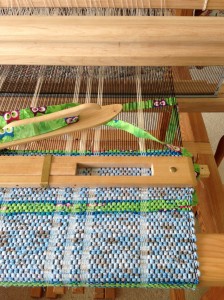I dabble in tapestry weaving–still in the insecure beginner stage. Tapestry weavers use a visual guide for weaving, called a cartoon, which is simply a drawing of the picture being woven. Placed directly under the weaving area, the cartoon shows the distinct lines to follow. It keeps everything in context with the overall design. Some people go through life without a meaningful guide, just hoping things turn out okay in the end.

Granted, my finished piece does not always end up looking like the cartoon. I am not trying to produce a masterpiece; but paying attention to what works and what doesn’t brings gradual improvement.
Life is an adventure, holding an unknown future. If you plunge forward, making up your own rules as you go, you risk ending up in an aimless mess. What if our master weaver has a cartoon designed for us, a map for our lives? I would rather choose that guided path rather than one with no direction. And when I miss the mark, he finds a way to fix it or weave around it. In the end, it becomes his masterpiece.
May the lines guiding your life tapestry be clearly drawn for you.
By design,
Karen




